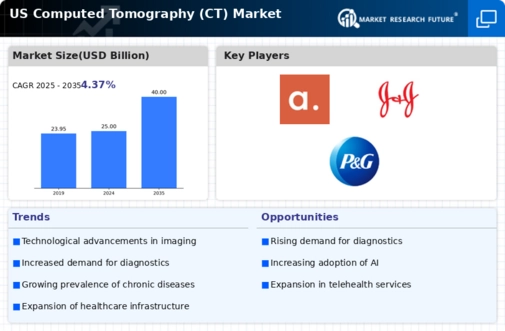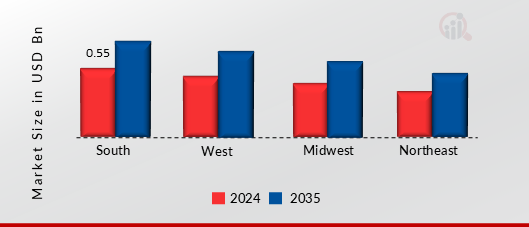Market Growth Projections
The Global US Computed Tomography (CT) Market Industry is projected to experience substantial growth over the next decade. With a market valuation anticipated to reach 25 USD Billion in 2024 and 40 USD Billion by 2035, the industry is poised for significant expansion. This growth trajectory is underpinned by a compound annual growth rate (CAGR) of 4.37% from 2025 to 2035. Such projections indicate a robust demand for CT imaging services, driven by technological advancements, increasing healthcare expenditure, and a growing emphasis on early diagnosis. These factors collectively contribute to a dynamic and evolving market landscape.
Technological Advancements
The Global US Computed Tomography (CT) Market Industry is experiencing rapid technological advancements, which are enhancing imaging capabilities and diagnostic accuracy. Innovations such as iterative reconstruction techniques and dual-energy CT are becoming increasingly prevalent. These advancements not only improve image quality but also reduce radiation exposure, making CT scans safer for patients. As a result, healthcare providers are more inclined to invest in advanced CT systems, contributing to the market's growth. The market is projected to reach 25 USD Billion in 2024, reflecting the increasing adoption of these technologies in clinical settings.
Increased Healthcare Expenditure
The Global US Computed Tomography (CT) Market Industry benefits from increased healthcare expenditure, which is a significant driver of market growth. Governments and private sectors are investing heavily in healthcare infrastructure, particularly in advanced imaging technologies. This investment is essential for enhancing diagnostic capabilities and improving patient outcomes. As healthcare budgets expand, hospitals and clinics are more likely to upgrade their imaging equipment, including CT scanners. This trend is anticipated to sustain a compound annual growth rate (CAGR) of 4.37% from 2025 to 2035, reflecting the ongoing commitment to improving healthcare services.
Rising Awareness of Early Diagnosis
The Global US Computed Tomography (CT) Market Industry is also influenced by the rising awareness of the importance of early diagnosis in disease management. Public health campaigns and educational initiatives are emphasizing the benefits of early detection, particularly for life-threatening conditions. As awareness grows, patients are more likely to seek diagnostic imaging services, including CT scans. This shift in patient behavior is expected to drive market growth, as healthcare providers respond to the increased demand for early diagnostic services. The focus on preventive healthcare is likely to further enhance the role of CT in clinical practice.
Growing Demand for Diagnostic Imaging
The Global US Computed Tomography (CT) Market Industry is witnessing a surge in demand for diagnostic imaging services. This trend is driven by an aging population and a rising prevalence of chronic diseases, such as cancer and cardiovascular conditions. As healthcare systems strive to provide timely and accurate diagnoses, the reliance on CT imaging continues to grow. This increased demand is expected to propel the market towards a valuation of 40 USD Billion by 2035. Consequently, healthcare facilities are expanding their imaging capabilities, further solidifying the role of CT in modern diagnostics.
Regulatory Support and Reimbursement Policies
The Global US Computed Tomography (CT) Market Industry is positively impacted by supportive regulatory frameworks and favorable reimbursement policies. Government agencies are increasingly recognizing the value of advanced imaging technologies in improving patient care. As a result, reimbursement rates for CT scans are becoming more favorable, encouraging healthcare providers to adopt these technologies. This regulatory support not only enhances access to CT imaging but also promotes innovation within the industry. Consequently, the market is expected to thrive as healthcare systems align with these supportive policies, ensuring that patients receive timely and effective diagnostic services.





